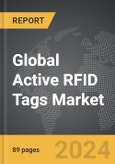The global market for Active RFID Tags was valued at US$5.7 Billion in 2024 and is projected to reach US$9.9 Billion by 2030, growing at a CAGR of 9.5% from 2024 to 2030. This comprehensive report provides an in-depth analysis of market trends, drivers, and forecasts, helping you make informed business decisions. The report includes the most recent global tariff developments and how they impact the Active RFID Tags market.
Segments: Application (Logistics & Transportation, Retail & Consumer Goods, Automotive, Healthcare & Medical, Aerospace & Defense, Other Applications).
Geographic Regions/Countries: World; United States; Canada; Japan; China; Europe (France; Germany; Italy; United Kingdom; Spain; Russia; and Rest of Europe); Asia-Pacific (Australia; India; South Korea; and Rest of Asia-Pacific); Latin America (Argentina; Brazil; Mexico; and Rest of Latin America); Middle East (Iran; Israel; Saudi Arabia; United Arab Emirates; and Rest of Middle East); and Africa.
The analysts continuously track trade developments worldwide, drawing insights from leading global economists and over 200 industry and policy institutions, including think tanks, trade organizations, and national economic advisory bodies. This intelligence is integrated into forecasting models to provide timely, data-driven analysis of emerging risks and opportunities.
Global Active RFID Tags Market - Key Trends and Drivers Summarized
Why Are Active RFID Tags Changing the Way We Track and Manage Assets?
Active RFID (Radio Frequency Identification) tags are revolutionizing asset tracking and management systems across a wide range of industries by providing real-time location data and advanced functionality that passive RFID systems cannot offer. Unlike passive RFID tags, which rely on external readers to activate them, active RFID tags have their own power source, typically a battery, allowing them to continuously transmit data over longer distances. This capability makes them particularly useful in large-scale operations such as warehouse management, logistics, healthcare, and manufacturing, where tracking assets in real-time is crucial for efficiency and accuracy. Active RFID tags can be used to monitor the location, movement, and status of high-value assets, inventory, and even people, offering unparalleled visibility and control in environments that require precise and constant tracking. This technology is transforming how companies handle supply chains, enabling more efficient processes, reducing losses, and improving decision-making through real-time data. As industries continue to digitize and automate, the adoption of active RFID tags is becoming an integral part of smart asset management systems.How Do Active RFID Tags Compare to Other Tracking Technologies?
While there are several tracking technologies available, active RFID tags stand out for their ability to provide long-range, real-time data, which sets them apart from passive RFID tags and other technologies like GPS or Bluetooth-based systems. Passive RFID tags, commonly used for inventory management and short-range tracking, require close proximity to a reader to transmit data, limiting their effectiveness in large or complex environments. Active RFID tags, on the other hand, can transmit signals over hundreds of meters, making them ideal for tracking assets across vast areas, such as shipping yards, hospitals, or distribution centers. This longer range capability reduces the need for extensive infrastructure, such as multiple readers or sensors, thereby simplifying large-scale tracking solutions. Compared to GPS, active RFID tags offer lower power consumption and do not require line-of-sight communication, allowing them to function more reliably indoors or in densely built environments where GPS signals may be obstructed. Bluetooth Low Energy (BLE) solutions are useful for certain applications but tend to offer shorter battery life and range compared to active RFID tags. The combination of long-range communication, durability, and lower power requirements makes active RFID tags an attractive option for industries that need continuous monitoring of assets in real time, without the limitations of alternative technologies.What Are the Primary Applications of Active RFID Tags?
Active RFID tags have a wide array of applications across industries such as logistics, healthcare, manufacturing, and retail, all of which benefit from the real-time tracking and advanced functionality these tags offer. In logistics and supply chain management, active RFID tags are used to track the movement of goods and vehicles across vast distances, ensuring that products arrive on time and in the correct condition. For example, shipping containers equipped with active RFID tags can be tracked as they move through ports and warehouses, providing detailed location data and ensuring that each container follows the correct route. In healthcare, active RFID tags are used to monitor the location of medical equipment, personnel, and patients, enhancing efficiency and safety within hospitals. By tagging critical devices such as defibrillators and IV pumps, hospitals can ensure that these items are always available when needed, reducing delays in patient care. Similarly, tracking patients with RFID tags can help prevent them from wandering into restricted areas or leaving the facility unnoticed. In the manufacturing sector, active RFID tags improve asset management by tracking machinery, tools, and raw materials throughout the production process, helping companies optimize workflows and minimize downtime. Additionally, retail companies are leveraging active RFID tags to enhance inventory visibility, manage stock levels, and prevent theft. These applications demonstrate the versatility of active RFID tags, as they enable real-time data collection and analytics that lead to more informed decision-making, improved operational efficiency, and enhanced security.What Is Driving the Growth in the Active RFID Tags Market?
The growth in the active RFID tags market is driven by several factors, each reflecting a combination of technological advancements, changing industry demands, and the increasing adoption of real-time tracking solutions. One of the key drivers is the growing need for efficient supply chain and inventory management across industries, particularly in logistics, manufacturing, and retail. As companies look for ways to improve operational efficiency and reduce costs, active RFID tags offer a reliable solution for tracking assets in real time, optimizing workflow processes, and minimizing losses due to misplaced or stolen goods. The rise of Industry 4.0, characterized by increased automation and data exchange, is further accelerating the adoption of active RFID technology, as these tags enable the seamless integration of real-time data into asset management systems and IoT networks. Additionally, advancements in RFID technology, such as longer battery life, improved signal range, and enhanced durability, are making active RFID tags more attractive to a broader range of applications, particularly in challenging environments like warehouses, shipping yards, and industrial plants. The growing emphasis on worker safety and regulatory compliance, especially in industries like healthcare and construction, is also contributing to the increased use of active RFID tags for tracking personnel and equipment. These tags can help organizations meet safety standards by ensuring that equipment is properly maintained and available, and that workers are safe and accounted for in hazardous environments. Moreover, the rising trend of smart cities and connected infrastructures is creating new opportunities for active RFID tags, which are increasingly being used in urban planning, traffic management, and public safety applications. As the demand for real-time data and efficient asset tracking continues to grow across industries, the active RFID tags market is expected to expand, driven by the need for more advanced and reliable tracking solutions.Report Scope
The report analyzes the Active RFID Tags market, presented in terms of units. The analysis covers the key segments and geographic regions outlined below.Segments: Application (Logistics & Transportation, Retail & Consumer Goods, Automotive, Healthcare & Medical, Aerospace & Defense, Other Applications).
Geographic Regions/Countries: World; United States; Canada; Japan; China; Europe (France; Germany; Italy; United Kingdom; Spain; Russia; and Rest of Europe); Asia-Pacific (Australia; India; South Korea; and Rest of Asia-Pacific); Latin America (Argentina; Brazil; Mexico; and Rest of Latin America); Middle East (Iran; Israel; Saudi Arabia; United Arab Emirates; and Rest of Middle East); and Africa.
Key Insights:
- Market Growth: Understand the significant growth trajectory of the Logistics & Transportation segment, which is expected to reach US$3.1 Billion by 2030 with a CAGR of a 9.7%. The Retail & Consumer Goods segment is also set to grow at 11.0% CAGR over the analysis period.
- Regional Analysis: Gain insights into the U.S. market, valued at $1.5 Billion in 2024, and China, forecasted to grow at an impressive 12.7% CAGR to reach $2.2 Billion by 2030. Discover growth trends in other key regions, including Japan, Canada, Germany, and the Asia-Pacific.
Why You Should Buy This Report:
- Detailed Market Analysis: Access a thorough analysis of the Global Active RFID Tags Market, covering all major geographic regions and market segments.
- Competitive Insights: Get an overview of the competitive landscape, including the market presence of major players across different geographies.
- Future Trends and Drivers: Understand the key trends and drivers shaping the future of the Global Active RFID Tags Market.
- Actionable Insights: Benefit from actionable insights that can help you identify new revenue opportunities and make strategic business decisions.
Key Questions Answered:
- How is the Global Active RFID Tags Market expected to evolve by 2030?
- What are the main drivers and restraints affecting the market?
- Which market segments will grow the most over the forecast period?
- How will market shares for different regions and segments change by 2030?
- Who are the leading players in the market, and what are their prospects?
Report Features:
- Comprehensive Market Data: Independent analysis of annual sales and market forecasts in US$ Million from 2024 to 2030.
- In-Depth Regional Analysis: Detailed insights into key markets, including the U.S., China, Japan, Canada, Europe, Asia-Pacific, Latin America, Middle East, and Africa.
- Company Profiles: Coverage of players such as Beijing Tangan, BioEnable Technologies Pvt, ChuanDa KeHong New Technology, Dahua Technology, ELA Innovation and more.
- Complimentary Updates: Receive free report updates for one year to keep you informed of the latest market developments.
Some of the 33 companies featured in this Active RFID Tags market report include:
- Beijing Tangan
- BioEnable Technologies Pvt
- ChuanDa KeHong New Technology
- Dahua Technology
- ELA Innovation
- FALCOM GmbH
- Guangdong Xinye
- InfinIDTech
- Jinco Universal
- Omni-ID
- OrangeTags
- Real Time Location Ltd
- Shenzhen Marktrace Co., Ltd
- Skyrfid
- SYRIS Technology Corp
Tariff Impact Analysis: Key Insights for 2025
Global tariff negotiations across 180+ countries are reshaping supply chains, costs, and competitiveness. This report reflects the latest developments as of April 2025 and incorporates forward-looking insights into the market outlook.The analysts continuously track trade developments worldwide, drawing insights from leading global economists and over 200 industry and policy institutions, including think tanks, trade organizations, and national economic advisory bodies. This intelligence is integrated into forecasting models to provide timely, data-driven analysis of emerging risks and opportunities.
What’s Included in This Edition:
- Tariff-adjusted market forecasts by region and segment
- Analysis of cost and supply chain implications by sourcing and trade exposure
- Strategic insights into geographic shifts
Buyers receive a free July 2025 update with:
- Finalized tariff impacts and new trade agreement effects
- Updated projections reflecting global sourcing and cost shifts
- Expanded country-specific coverage across the industry
Table of Contents
I. METHODOLOGYII. EXECUTIVE SUMMARY2. FOCUS ON SELECT PLAYERSIII. MARKET ANALYSISSOUTH KOREAREST OF ASIA-PACIFICARGENTINABRAZILMEXICOREST OF LATIN AMERICAIRANISRAELSAUDI ARABIAUNITED ARAB EMIRATESREST OF MIDDLE EASTIV. COMPETITION
1. MARKET OVERVIEW
3. MARKET TRENDS & DRIVERS
4. GLOBAL MARKET PERSPECTIVE
UNITED STATES
CANADA
JAPAN
CHINA
EUROPE
FRANCE
GERMANY
ITALY
UNITED KINGDOM
SPAIN
RUSSIA
REST OF EUROPE
ASIA-PACIFIC
AUSTRALIA
INDIA
LATIN AMERICA
MIDDLE EAST
AFRICA
Companies Mentioned (Partial List)
A selection of companies mentioned in this report includes, but is not limited to:
- Beijing Tangan
- BioEnable Technologies Pvt
- ChuanDa KeHong New Technology
- Dahua Technology
- ELA Innovation
- FALCOM GmbH
- Guangdong Xinye
- InfinIDTech
- Jinco Universal
- Omni-ID
- OrangeTags
- Real Time Location Ltd
- Shenzhen Marktrace Co., Ltd
- Skyrfid
- SYRIS Technology Corp
Table Information
| Report Attribute | Details |
|---|---|
| No. of Pages | 89 |
| Published | April 2025 |
| Forecast Period | 2024 - 2030 |
| Estimated Market Value ( USD | $ 5.7 Billion |
| Forecasted Market Value ( USD | $ 9.9 Billion |
| Compound Annual Growth Rate | 9.5% |
| Regions Covered | Global |









